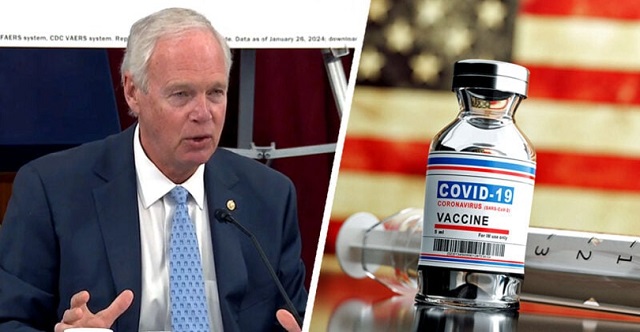COVID-19
FDA lab uncovers excess DNA contamination in COVID-19 vaccines

|
|
Explosive revelations as a study conducted at FDA’s own lab found residual DNA levels exceeded safety limits by 6 to 470 times. Experts say it’s a ‘smoking gun.’
An explosive new study conducted within the U.S. Food and Drug Administration’s (FDA) own laboratory has revealed excessively high levels of DNA contamination in Pfizer’s mRNA COVID-19 vaccine.
Tests conducted at the FDA’s White Oak Campus in Maryland found that residual DNA levels exceeded regulatory safety limits by 6 to 470 times.
The study was undertaken by student researchers under the supervision of FDA scientists. The vaccine vials were sourced from BEI Resources, a trusted supplier affiliated with the National Institute of Allergy and Infectious Diseases (NIAID), previously headed by Anthony Fauci.
Recently published in the Journal of High School Science, the peer-reviewed study challenges years of dismissals by regulatory authorities, who had previously labelled concerns about excessive DNA contamination as baseless.
The FDA is expected to comment on the findings this week. However, the agency has yet to issue a public alert, recall the affected batches, or explain how vials exceeding safety standards were allowed to reach the market.
The Methods
The student researchers employed two primary analytical methods:
- NanoDrop Analysis – This technique uses UV spectrometry to measure the combined levels of DNA and RNA in the vaccine. While it provides an initial assessment, it tends to overestimate DNA concentrations due to interference from RNA, even when RNA-removal kits are utilised.
- Qubit Analysis – For more precise measurements, the researchers relied on the Qubit system, which quantifies double-stranded DNA using fluorometric dye.
Both methods confirmed the presence of DNA contamination far above permissible thresholds. These findings align with earlier reports from independent laboratories in the United States, Canada, Australia, Germany and France.
Expert Reaction
Kevin McKernan, a former director of the Human Genome Project, described the findings as a “bombshell,” criticising the FDA for its lack of transparency.
“These findings are significant not just for what they reveal but for what they suggest has been concealed from public scrutiny. Why has the FDA kept these data under wraps?” McKernan questioned.
While commending the students’ work, he also noted limitations in the study’s methods, which may have underestimated contamination levels.
“The Qubit analysis can under-detect DNA by up to 70% when enzymes are used during sample preparation,” McKernan explained. “Additionally, the Plasmid Prep kit used in the study does not efficiently capture small DNA fragments, further contributing to underestimation.”
In addition to genome integration, McKernan highlighted another potential cancer-causing mechanism of DNA contamination in the vaccines.
He explained that plasmid DNA fragments entering the cell’s cytoplasm with the help of lipid nanoparticles, could overstimulate the cGAS-STING pathway, a crucial component of the innate immune response.
“Chronic activation of the cGAS-STING pathway could paradoxically fuel cancer growth,” McKernan warned. “Repeated exposure to foreign DNA through COVID-19 boosters may amplify this risk over time, creating conditions conducive to cancer development.”
Adding to the controversy, traces of the SV40 promoter were detected among the DNA fragments. While the authors concluded these fragments were “non-replication-competent” meaning they cannot replicate in humans, McKernan disagreed.
“To assert that the DNA fragments are non-functional, they would need to transfect mammalian cells and perform sequencing, which wasn’t done here,” McKernan stated.
“Moreover, the methods used in this study don’t effectively capture the full length of DNA fragments. A more rigorous sequencing analysis could reveal SV40 fragments several thousand base pairs long, which would likely be functional,” he added.
Regulatory Oversight Under Scrutiny
Nikolai Petrovsky, a Professor of Immunology and director of Vaxine Pty Ltd, described the findings as a “smoking gun.”
“It clearly shows the FDA was aware of these data. Given that these studies were conducted in their own labs under the supervision of their own scientists, it would be hard to argue they were unaware,” he said.
 |
Nikolai Petrovsky, Professor of Immunology and Infectious Disease at the Australian Respiratory and Sleep Medicine Institute in Adelaide
Prof Petrovsky praised the quality of work carried out by the students at the FDA labs.
“The irony is striking,” he remarked. “These students performed essential work that the regulators failed to do. It’s not overly complicated—we shouldn’t have had to rely on students to conduct tests that were the regulators’ responsibility in the first place.”
The Australian Therapeutic Goods Administration (TGA), which has consistently defended the safety of the mRNA vaccines, released its own batch testing results, claiming they met regulatory standards. However, Prof Petrovsky criticised the TGA’s testing methods.
“The TGA’s method was not fit for purpose,” he argued. “It didn’t assess all the DNA in the vials. It only looked for a small fragment, which would severely underestimate the total amount of DNA detected.”
Implications for Manufacturers and Regulators
Now that DNA contamination of the mRNA vaccines has been verified in the laboratory of an official agency and published in a peer-reviewed journal, it becomes difficult to ignore.
It also places vaccine manufacturers and regulators in a precarious position.
Addressing the contamination issue would likely require revising manufacturing processes to remove residual DNA, which Prof Petrovsky explained would be impractical.
“The only practical solution is for regulators to require manufacturers to demonstrate that the plasmid DNA levels in the vaccines are safe,” Prof Petrovsky stated.
“Otherwise, efforts to remove the residual DNA would result in an entirely new vaccine, requiring new trials and effectively restarting the process with an untested product.”
Now the onus is on regulators to provide clarity and take decisive action to restore confidence in their oversight. Anything less risks deepening the scepticism of the public.
Both the US and Australian drug regulators have been approached for comment.
Please consider becoming a subscriber.
COVID-19
Senator Demands Docs After ‘Blockbuster’ FDA Memo Links Child Deaths To COVID Vaccine


From the Daily Caller News Foundation
By Emily Kopp
The letter, exclusively shared with the Daily Caller News Foundation, seeks more details about those deaths and the passive U.S. vaccine safety surveillance system and complacent Food and Drug Administration (FDA) bureaucracy under the Biden administration that delayed their reporting for years.
“Nobody wanted to admit that these things were causing death. This is absolutely a case of willful ignorance,” Johnson said in an interview with the DCNF.
As a nonprofit, we are dependent on the generosity of our readers.
Please consider making a small donation of any amount here.
Thank you!
The letter requests from the Department of Health and Human Services (HHS) “all records referring or relating to the review of the 96 reports of death following a COVID-19 vaccine … including but not limited to, any memorandum or report created following that review and the data underlying the reports.”
“I am grateful that we now have individuals at our federal health agencies who care about vaccine safety and efficacy. I am, however, disappointed that despite having subpoenaed HHS for the type of data and information described in Dr. Prasad’s memo, it does not appear to have been provided to my office,” the letter reads.
HHS did not immediately respond to a request for comment.
“This is a profound revelation. For the first time, the US FDA will acknowledge that COVID-19 vaccines have killed American children. Healthy young children who faced tremendously low risk of death were coerced, at the behest of the Biden administration, via school and work mandates, to receive a vaccine that could result in death. In many cases, such mandates were harmful. It is difficult to read cases where kids aged 7 to 16 may be dead as a result of covid vaccines,” Prasad wrote. “There is no doubt that without this FDA commissioner [Marty Makary], we would not have performed this investigation and identified this safety concern. This fact also demands serious introspection and reform.”
“One reason I’m writing this letter is that this memo needs much greater attention. This should be a blockbuster,” the Wisconsin senator told the DCNF.
Johnson, who has investigated the issue of COVID vaccine-linked adverse events since June 2021, also seeks more clarity about why FDA only examined a fraction of total reports to the Vaccine Adverse Event Reporting System (VAERS). He noted that the 96 deaths scrutinized by FDA staff in its investigation represents a sliver of the raw VAERS reports of 9,299 deaths worldwide within two days of vaccination.
Distinguishing which VAERS reports indicate genuine fatal side effects and which represent mere coincidences requires autopsy reports, which regulators and physicians often do not request because of a ideological reluctance to acknowledge that vaccines can carry risks, Johnson told the DCNF. Johnson said he has spoken to families who suspected a vaccine injury but struggled to obtain autopsies.
“With some of these officials at federal health agencies and within the medical establishment, vaccines are religion. The do not want to muddy the water with facts,” he said.
Johnson’s letter notes that Prasad acknowledged a culture at FDA “where vaccines are exculpated rather than indicted in cases of ambiguity,” and that the true number of deaths is likely higher.
Johnson has as chair of the Senate Permanent Subcommittee on Investigations investigated the Biden administration’s headlong expansion of COVID vaccines and booster shots to healthy young adults and children.
His committee uncovered internal federal documents showing the Centers for Disease Control and Prevention never updated its vaccine surveillance tool “V-Safe” to include cardiac symptoms, despite naming myocarditis as a potential adverse event by October 2020, per a May report. The investigation also found that top officials at FDA obstructed a warning to pediatricians and other providers about the risk of myocarditis after the May 2021 authorization of the Pfizer vaccine for 12 to 15-year-olds, months after Israeli health officials first detected the safety signal in February 2021.
Johnson’s letter highlights missing safety studies that the drugmakers never conducted.
Under the Biden administration, the FDA waived the responsibility of the drugmakers to conduct post-market studies that they had pledged to regulators, scientific advisors on the FDA Vaccines and Related Products Advisory Committee, and the public that they would complete. These uncompleted studies include promised research into subclinical myocarditis, undocumented rates of heart inflammation without obvious symptoms, Prasad’s memo states.
Johnson’s letter reveals the committee has not received any records from HHS about the liability shield for COVID-19 vaccines.
A public health media personality reported on Dec. 11 that FDA staff had downgraded the certainty with which it can attribute some the deaths to the vaccine in the weeks since Prasad received their top line results — echoing prior leaks from career officials aimed at undermining FDA’s new bosses.
Center for Drug Evaluation and Research Acting Director Tracy Beth Hoeg first concluded in a separate analysis that there were in fact deaths in children in the summer, but career staff leaked the results to reporters who “portrayed the incident as Dr. Hoeg attempting to create a false fear regarding vaccines” soon after, per Prasad’s memo.
Johnson’s letter seeks documentation of Hoeg’s meeting, including “a list of all attendees.”
COVID-19
China Retaliates Against Missouri With $50 Billion Lawsuit In Escalating Covid Battle


From the Daily Caller News Foundation
China is escalating its legal fight with Missouri after the state secured a massive court victory earlier this year over Beijing’s role in the COVID-19 pandemic, according to the state attorney general’s office.
Missouri Attorney General Catherine Hanaway announced Tuesday that the People’s Government of Wuhan Municipality, the Chinese Academy of Sciences and the Wuhan Institute of Virology have filed a $50 billion lawsuit against the state, claiming Missouri poses an “economic and reputational threat” to the People’s Republic of China (PRC). The suit comes as Missouri moves to seize Chinese-owned assets to collect on a historic federal court judgment the state won in March.
Missouri first sued China in 2020, seeking $25 billion in damages “for causing and exacerbating the COVID-19 pandemic” and for hoarding critical medical supplies while the virus spread, according to the state attorney general’s office. China and several affiliated entities were ordered to pay Missouri roughly $24.49 billion, plus post-judgment interest. Senior U.S. District Judge Stephen Limbaugh ruled that China and the other defendants “failed to appear or otherwise answer after being properly served,” resulting in the default judgment.
As a nonprofit, we are dependent on the generosity of our readers.
Please consider making a small donation of any amount here.
Thank you!
Missouri maintained that China was attempting to shield itself from legal consequences by relying on proxy organizations to speak on its behalf — an accusation Beijing now disputes in its own lawsuit against the state.
In its lawsuit, China alleges that Missouri’s actions have had “negative effects on the soft power” of Wuhan and have “belittled the social evaluation” as well as adversely affected the “productivity and commercialization of scientific and technological achievements” of the Chinese Academy of Sciences and the Wuhan Institute of Virology. The filing further alleges that Missouri’s “vexatious litigation” has “defamed Plaintiffs’ reputation, resulting in huge economic losses of the Plaintiffs, and deeply endangering sovereignty, security and development interests of China.”
The suit names the state of Missouri, Republican Missouri Sen. Eric Schmitt and the former Missouri Attorney General Andrew Bailey as the defendants.
China’s lawsuit demands the defendants “issue public apologies on New York Times, CNN, Wall Street Journal, Washington Post, YouTube and other American media or internet platforms, and People’s Daily, Xinhuanet and other Chinese media or internet platforms.”
Hanaway rejected the demand and said the state remains focused on enforcing the federal judgment.
“I find it extremely telling that the Chinese blame our great state for ‘belittling the social evaluation’ of The Wuhan Institute of Virology. This lawsuit is a stalling tactic and tells me that we have been on the right side of this issue all along,” Hanaway said in a statement. “We stand undeterred in our mission to collect on our $24 billion judgment that was lawfully handed down in federal court.”
Schmitt described China’s suit as “frivolous lawfare, attempting to absolve themselves of all wrongdoing in the early days of the pandemic.”
“This is their way of distracting from what the world already knows, China has blood on its hands. China lied about the origins of COVID virus, they tried to cover it up, and they upended the world by creating a global pandemic that resulted in immense human loss,” Schmitt added.
Missouri, Hanaway said, is continuing efforts to obtain certification that would allow the state to seize Chinese-owned assets, including real estate, financial interests, and other holdings tied to the defendants.
-

 International2 days ago
International2 days agoBondi Beach Shows Why Self-Defense Is a Vital Right
-

 Business2 days ago
Business2 days agoOttawa Pretends To Pivot But Keeps Spending Like Trudeau
-

 Energy2 days ago
Energy2 days agoLiberals Twisted Themselves Into Pretzels Over Their Own Pipeline MOU
-

 Censorship Industrial Complex2 days ago
Censorship Industrial Complex2 days agoHow Wikipedia Got Captured: Leftist Editors & Foreign Influence On Internet’s Biggest Source of Info
-

 Crime1 day ago
Crime1 day agoBondi Beach Survivor Says Cops Prevented Her From Fighting Back Against Terrorists
-

 Automotive1 day ago
Automotive1 day agoFord’s EV Fiasco Fallout Hits Hard
-

 Crime1 day ago
Crime1 day agoThe Uncomfortable Demographics of Islamist Bloodshed—and Why “Islamophobia” Deflection Increases the Threat
-

 Frontier Centre for Public Policy16 hours ago
Frontier Centre for Public Policy16 hours agoCanada Lets Child-Porn Offenders Off Easy While Targeting Bible Believers








